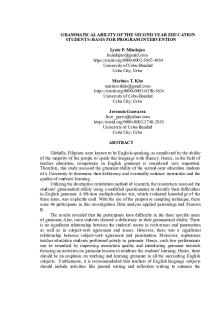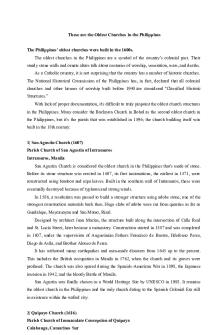The Five Grammatical Units PDF

| Title | The Five Grammatical Units |
|---|---|
| Course | Gramática Inglesa |
| Institution | Universidad Argentina de la Empresa |
| Pages | 3 |
| File Size | 117.2 KB |
| File Type | |
| Total Downloads | 88 |
| Total Views | 144 |
Summary
Resumen sobre las 5 unidades gramaticales en ingles....
Description
LESSON 2: THE FIVE GRAMMATICAL UNITS When we deal with syntax, we have to focus on grammatical units. Which are the grammatical units? And how many grammatical units are there? According to Halliday (1961), a British linguist, in English grammar there are five grammatical units: 1. 2. 3. 4. 5.
the sentence the clause the phrase the word and the morpheme
The sentence is the largest or "highest" unit. Its beginning is marked by the use of capital letters and its end by a full stop. The morpheme is the smallest or "lowest" unit. Halliday arranges all five units on a scale of rank, saying that units of higher rank are composed of or made up of units of lower rank. The relation between the five units is, therefore, one of composition or constituency. The sentence is composed of one or more clauses, for example: [(Mr. Funny lived in a teapot).] is one sentence made up of one main, free or independent clause . In this case sentence and clause coincide. A sentence may consist of a single clause. We will use square brackets to mark the beginning and end of sentences, and round brackets to mark clauses within sentences but this is just a convention. However, if we consider the second sentence of the text: [(It had two bedrooms, a bathroom, a kitchen and a living room) and (it suited Mr. Funny very nicely).] what we find is one sentence made up of two main, free or independent clauses. If we dropped the word and, and wrote a full stop instead, each of the main clauses could stand on its own, e.g.: [It had two bedrooms, a bathroom, a kitchen and a living room .] [It suited Mr. Funny very nicely.] If we consider the sentences: [“Delicious,” he murmured to himself .] [Have you ever seen a car ?]
Page 1 of 3
We will see that the units as he finished his funny lunch and that looks like a shoe cannot stand on their own. We will also call them clauses but they are not main, free or independent clauses. We will call them subordinate or dependent clauses. Subordinate clauses are not free or independent as main clauses are. TO SUM UP: Clauses can be classified into a. Main, free or independent and b, Subordinate or dependent. Main, free or independent Clauses Subordinate or dependent
Now let’s go back to the five grammatical units. We have said so far that according to Halliday the sentence is made up of clauses. What is the clause made up of? The clause is composed, or made up, of one or more phrases. For example the sentence: [Mr. Funny lived in a teapot.] is made up of two phrases, a noun phrase1 Mr. Funny and a verb phrase lived in a teapot. What is the phrase made up of? The phrase is composed of one or more words. What is the word made up of? The word is composed of one or more morphemes. By morpheme we understand a minimum unit of form and meaning. Morphemes may be free or bound. A free morpheme is one that can stand on its own. There may be cases where word and morpheme coincide. In the case of live we have one word and one free morpheme. In the case of teapot we have one word made up of two free morphemes tea and pot. A bound morpheme is one that cannot stand on its own. It may be an inflection such as –ed in suited, or a word formation affix (prefix or suffix) such as -ly in nicely. If they are inflectional, they help us define the type of word we have, i.e. they help us define the category. If they are word formation affixes, they are called derivational and their function is to create or derive new words. TO SUM UP: Morphemes can be classified into a. Free and b. Bound: Free Morphemes Bound
Bound morphemes in turn can be a. Inflectional or b. derivational: Free 1
Traditional Grammar calls this a noun phrase. We will later refer to these phrases as determiner phrases. This other label comes from the framework of Generative Grammar.
Page 2 of 3
Morphemes
Inflectional Bound Derivational
What is the morpheme made up of? Nothing. The morpheme has no grammatical structure precisely because it is the smallest unit. And the sentence, which is the largest, does not enter into the structure of any unit. There is nothing above the sentence at the level of grammar. It is the largest unit of syntactic description. What we have done so far is called a "top to bottom" analysis. However, instead of saying that a sentence can be broken down into smaller and smaller units we might also look at the sentence the other way around, that is "from bottom to top", and say that the units can combine to form increasingly larger units. One or more than one morpheme may constitute a word, one or more than one word may form a phrase, one or more than one phrase may form a clause, one or more than one clause may form a sentence.
Page 3 of 3...
Similar Free PDFs

The Five Grammatical Units
- 3 Pages

The Five Factor Model
- 5 Pages

The Five Monkeys Experiment
- 2 Pages

Grammatical Proficiency revised
- 14 Pages

Grammatical and Lexical Cohesion
- 14 Pages

The Big Five Personality Test
- 1 Pages

The Five Parts of Rhetoric
- 2 Pages

Five - Apuntes Five
- 6 Pages

Mod Five - Mod Five
- 2 Pages

The-Five-Sexes-Gender-Learning
- 3 Pages

The five sexes - n/a
- 7 Pages
Popular Institutions
- Tinajero National High School - Annex
- Politeknik Caltex Riau
- Yokohama City University
- SGT University
- University of Al-Qadisiyah
- Divine Word College of Vigan
- Techniek College Rotterdam
- Universidade de Santiago
- Universiti Teknologi MARA Cawangan Johor Kampus Pasir Gudang
- Poltekkes Kemenkes Yogyakarta
- Baguio City National High School
- Colegio san marcos
- preparatoria uno
- Centro de Bachillerato Tecnológico Industrial y de Servicios No. 107
- Dalian Maritime University
- Quang Trung Secondary School
- Colegio Tecnológico en Informática
- Corporación Regional de Educación Superior
- Grupo CEDVA
- Dar Al Uloom University
- Centro de Estudios Preuniversitarios de la Universidad Nacional de Ingeniería
- 上智大学
- Aakash International School, Nuna Majara
- San Felipe Neri Catholic School
- Kang Chiao International School - New Taipei City
- Misamis Occidental National High School
- Institución Educativa Escuela Normal Juan Ladrilleros
- Kolehiyo ng Pantukan
- Batanes State College
- Instituto Continental
- Sekolah Menengah Kejuruan Kesehatan Kaltara (Tarakan)
- Colegio de La Inmaculada Concepcion - Cebu




